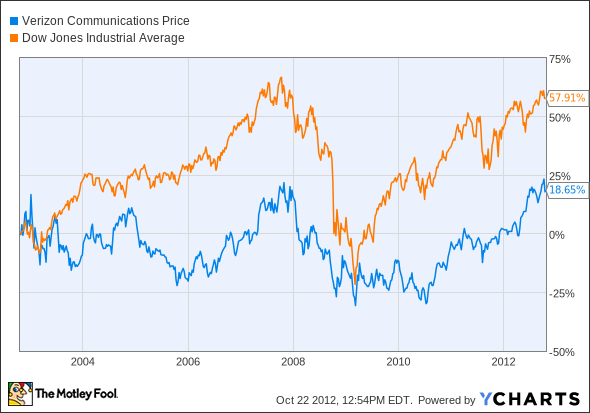How Dividends Change the Game for This Dow Stock
The wealth-building power of compound interest will never cease to amaze me.
It's a story of patience and attention to detail, where small differences in short time-scales add up to massive divergence over decades. And in the end, the biggest winners don't always deliver the fattest share-price returns.
Let me illustrate my point with a look at telecom titan Verizon (NYS: VZ) . Big Red hasn't given investors much to cheer about over the last decade, as the shares have lagged the broader Dow Jones Industrial Average (INDEX: ^DJI) by a wide margin:
Oh, but that's just plain-old market returns. Verizon turns the tables on its Dow peers if you also reinvest dividends along the way:
VZ Total Return Price data by YCharts.
The no-brainer decision to buy more Verizon shares with every payout check totally changes the game. A 23% return over 10 years turns into a 110% gain. In terms of annual returns, you're moving from a 2.1% yield -- roughly equivalent to a decent savings account -- to a 7.7% yearly return that no bank account can touch.
And here's the kicker: Verizon could have crushed the market even harder if management had poured more cash into dividends. The Verizon cash machine tends to print many more greenbacks than the generous dividend policy requires every year. Over the last four quarters, the company has spent $5.7 billion on dividend payments and a tiny amount of share buybacks -- out of $17 billion in free cash flow. That's a 33% payout policy.
Compare this to AT&T (NYS: T) , which issued $10.3 billion in dividend payments and spent $4.2 billion on net share repurchases out of $15.7 billion in free cash flow -- a 92% direct shareholder return.
Some might call AT&T borderline irresponsible for flushing so much cash out of its system, while others might expect Verizon to spend more in this area. Verizon could easily afford to double its payouts without risking any of its existing capital, and that would create a 9% dividend yield at today's prices.
It would be comparable to the ultra-rich yields you get from smaller rivals Frontier Communications (NAS: FTR) and Windstream (NAS: WIN) today, but with dramatically lower financial risk. Like AT&T, these mostly rural operators already spend the bulk of their free cash on dividends. But unlike those of Ma Bell or Verizon, their market caps are smaller than their debt loads. Guess which model would help me sleep better at night: high yields with weak cash-backing or lower payouts based on rock-solid cash flows?
If you're interested in some of these dividends on your quest for high-yielding stocks, The Motley Fool has compiled a special free report outlining our nine top dependable dividend-paying stocks. It's called "Secure Your Future With 9 Rock-Solid Dividend Stocks." You can access your copy today at no cost! Just click here to discover the winners we've picked.
The article How Dividends Change the Game for This Dow Stock originally appeared on Fool.com.
Fool contributor Anders Bylund has no positions in the stocks mentioned above. Check out Anders' bio and holdings, or follow him on Twitter and Google+.The Motley Fool has no positions in the stocks mentioned above. Motley Fool newsletter services recommend AT&T.; Try any of our Foolish newsletter services free for 30 days. We Fools may not all hold the same opinions, but we all believe that considering a diverse range of insights makes us better investors. The Motley Fool has a disclosure policy.
Copyright © 1995 - 2012 The Motley Fool, LLC. All rights reserved. The Motley Fool has a disclosure policy.



